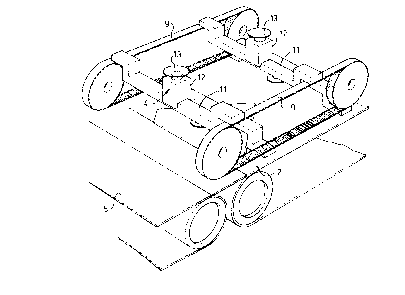Some of the information on this Web page has been provided by external sources. The Government of Canada is not responsible for the accuracy, reliability or currency of the information supplied by external sources. Users wishing to rely upon this information should consult directly with the source of the information. Content provided by external sources is not subject to official languages, privacy and accessibility requirements.
Any discrepancies in the text and image of the Claims and Abstract are due to differing posting times. Text of the Claims and Abstract are posted:
| (12) Patent Application: | (11) CA 2219957 |
|---|---|
| (54) English Title: | METHOD AND APPARATUS FOR POSITIONING OF ARTICLES |
| (54) French Title: | METHODE ET APPAREIL POUR PLACER DES OBJETS |
| Status: | Deemed Abandoned and Beyond the Period of Reinstatement - Pending Response to Notice of Disregarded Communication |
| (51) International Patent Classification (IPC): |
|
|---|---|
| (72) Inventors : |
|
| (73) Owners : |
|
| (71) Applicants : |
|
| (74) Agent: | SMART & BIGGAR LP |
| (74) Associate agent: | |
| (45) Issued: | |
| (22) Filed Date: | 1997-11-03 |
| (41) Open to Public Inspection: | 1998-05-04 |
| Availability of licence: | N/A |
| Dedicated to the Public: | N/A |
| (25) Language of filing: | English |
| Patent Cooperation Treaty (PCT): | No |
|---|
| (30) Application Priority Data: | ||||||
|---|---|---|---|---|---|---|
|
Method and apparatus for positioning slab-like articles on a
conveyor belt. The articles are engaged from above by pivoting means
moving along with the conveyor but (at least over some part of the path
or travel) with a substantially lower speed than the conveyor. Engagement
of the article is effected on a point remote from the centre of gravity
and if the article is triangular preferably on a median thereof.
Méthode et appareil pour placer des objets du genre dalle sur une bande transporteuse. Les objets sont déposés par le haut au moyen d'un dispositif pivotant se déplaçant avec la bande transporteuse, mais (au moins sur une partie du trajet) à une vitesse substantiellement inférieure à celle de la bande transporteuse. L'objet est déposé en un point éloigné de son centre de gravité et, si l'objet est triangulaire, de préférence sur une médiane du triangle.
Note: Claims are shown in the official language in which they were submitted.
Note: Descriptions are shown in the official language in which they were submitted.

2024-08-01:As part of the Next Generation Patents (NGP) transition, the Canadian Patents Database (CPD) now contains a more detailed Event History, which replicates the Event Log of our new back-office solution.
Please note that "Inactive:" events refers to events no longer in use in our new back-office solution.
For a clearer understanding of the status of the application/patent presented on this page, the site Disclaimer , as well as the definitions for Patent , Event History , Maintenance Fee and Payment History should be consulted.
| Description | Date |
|---|---|
| Time Limit for Reversal Expired | 2003-11-03 |
| Application Not Reinstated by Deadline | 2003-11-03 |
| Deemed Abandoned - Failure to Respond to Maintenance Fee Notice | 2002-11-04 |
| Inactive: Abandon-RFE+Late fee unpaid-Correspondence sent | 2002-11-04 |
| Letter Sent | 2002-03-01 |
| Inactive: Correspondence - Transfer | 2002-01-29 |
| Inactive: Office letter | 2002-01-02 |
| Application Published (Open to Public Inspection) | 1998-05-04 |
| Inactive: Single transfer | 1998-03-16 |
| Amendment Received - Voluntary Amendment | 1998-03-16 |
| Inactive: Correspondence - Formalities | 1998-03-16 |
| Inactive: First IPC assigned | 1998-03-05 |
| Classification Modified | 1998-02-24 |
| Inactive: IPC assigned | 1998-02-24 |
| Inactive: IPC assigned | 1998-02-24 |
| Inactive: Courtesy letter - Evidence | 1998-02-03 |
| Inactive: Filing certificate - No RFE (English) | 1998-01-27 |
| Filing Requirements Determined Compliant | 1998-01-27 |
| Application Received - Regular National | 1998-01-26 |
| Abandonment Date | Reason | Reinstatement Date |
|---|---|---|
| 2002-11-04 |
The last payment was received on 2001-10-30
Note : If the full payment has not been received on or before the date indicated, a further fee may be required which may be one of the following
Please refer to the CIPO Patent Fees web page to see all current fee amounts.
| Fee Type | Anniversary Year | Due Date | Paid Date |
|---|---|---|---|
| Application fee - standard | 1997-11-03 | ||
| Registration of a document | 1998-03-16 | ||
| MF (application, 2nd anniv.) - standard | 02 | 1999-11-03 | 1999-10-19 |
| MF (application, 3rd anniv.) - standard | 03 | 2000-11-02 | 2000-10-30 |
| MF (application, 4th anniv.) - standard | 04 | 2001-11-05 | 2001-10-30 |
| Registration of a document | 2001-11-07 |
Note: Records showing the ownership history in alphabetical order.
| Current Owners on Record |
|---|
| VAN DER ZON VAN DER WIEL, WILHELMINA JOHANNA CATHARINA MARIA |
| CSM NEDERLAND B.V. |
| Past Owners on Record |
|---|
| PETRUS WILHELMUS MARIA (DECEASED) VAN DER ZON |